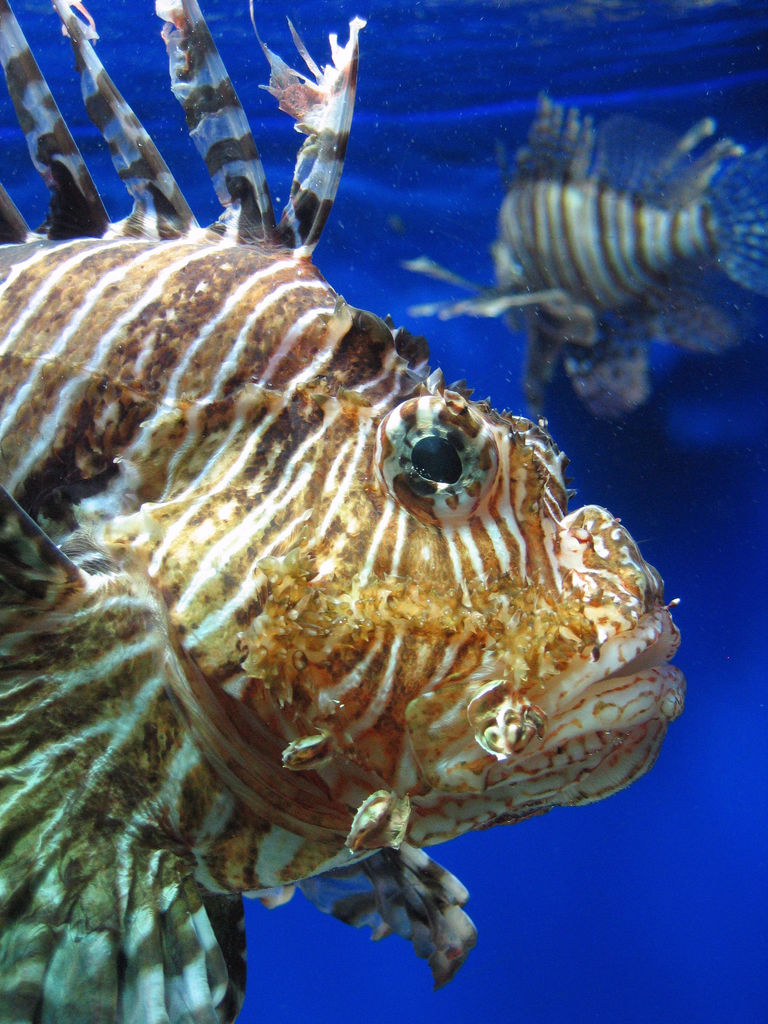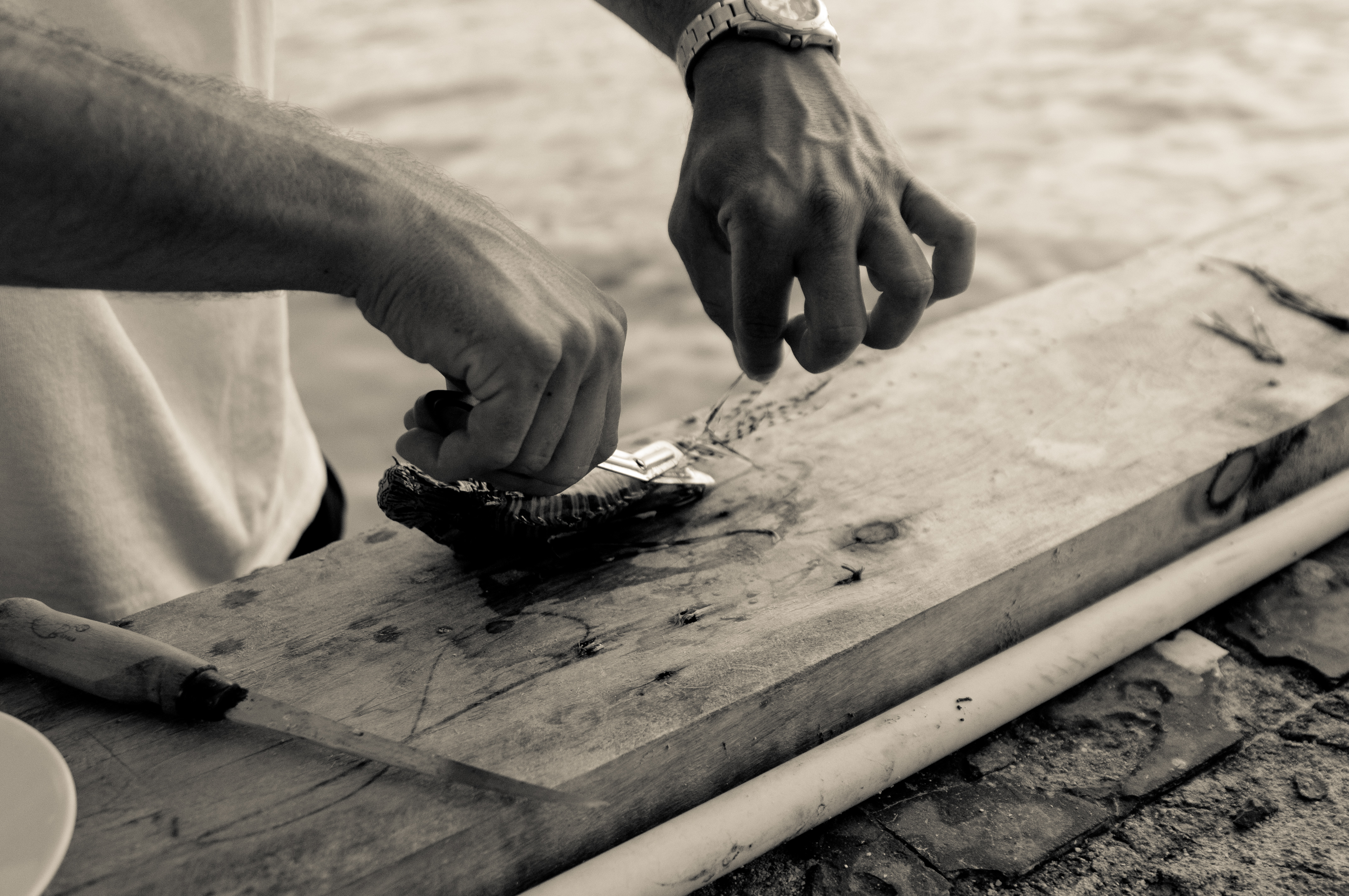 I first encountered lionfish on Carrie Bow Cay, a hurricane-battered scrap of an island 15 miles off the coast of Belize. The rotating crew of biologists on Carrie Bow work hard and play hard, and one popular form of play is lionfish hunting: spearing, cooking, and enthusiastically devouring these stripey fellows on the left. Lionfish are a troublesome invasive species, probably introduced to the Caribbean through the aquarium trade (but probably not, as is often rumored, via a beachside aquarium smashed by Hurricane Andrew). So the Carrie Bow pastime is not only tasty — fans of grilled lionfish told me it tastes like a cross between snapper and grouper — but also morally uplifting.
I first encountered lionfish on Carrie Bow Cay, a hurricane-battered scrap of an island 15 miles off the coast of Belize. The rotating crew of biologists on Carrie Bow work hard and play hard, and one popular form of play is lionfish hunting: spearing, cooking, and enthusiastically devouring these stripey fellows on the left. Lionfish are a troublesome invasive species, probably introduced to the Caribbean through the aquarium trade (but probably not, as is often rumored, via a beachside aquarium smashed by Hurricane Andrew). So the Carrie Bow pastime is not only tasty — fans of grilled lionfish told me it tastes like a cross between snapper and grouper — but also morally uplifting.
Sound enticing? If you can’t make it to Carrie Bow for dinner, you can join the Fourth Annual Lionfish Derby & Rodeo in the Bahamas this month, or participate in the National Oceanic and Atmospheric Administration’s “Eat Lionfish!” campaign, which has served up lionfish ceviche at the National Museum of Natural History. If lionfish aren’t your thing, other invasivore recipes abound. You can help feed the hungry with “Kentucky tuna,” otherwise known as Asian carp. You can serve snakehead appetizers at your wedding, or treat yourself to some kudzu-blossom sorbet. Just be sure you can still wiggle into a svelte nutria-fur cocktail dress.
But now, science is stepping in to spoil the fun — or at least temper it a bit. In a recent paper in Conservation  Letters, researchers say invasivore campaigns can help educate the public, encourage early identification and eradication of invasives, and benefit local economies through hunting and homegrown cuisine. And they can put a dent in invasive populations. As the authors write, with perhaps a soupçon of gallows humor, “The primary evidence in favor of gastronomic control is the many species humans have driven to extinction or near-collapse by overharvest.” Kentucky tuna, meet Atlantic cod.
Letters, researchers say invasivore campaigns can help educate the public, encourage early identification and eradication of invasives, and benefit local economies through hunting and homegrown cuisine. And they can put a dent in invasive populations. As the authors write, with perhaps a soupçon of gallows humor, “The primary evidence in favor of gastronomic control is the many species humans have driven to extinction or near-collapse by overharvest.” Kentucky tuna, meet Atlantic cod.
But invasive species are notoriously hardy, surviving and even thriving in the face of attacks. Weedy invasive grasses in the U.S. Southwest are often the first to recover from wildfires; lionfish bounce back quickly from even severe overfishing. And the researchers caution that invasivore campaigns risk becoming victims of their own success: If invasive species become popular enough, whether as dinner or as cultural icons, the public may want to protect them, not kill them. (Wild horses, descendants of domesticated horses introduced to the Western U.S. by Spanish explorers, are now protected under federal law as “living symbols of the historic and pioneer spirit of the West.”)
So what’s a well-intentioned invasivore to do? The authors advise, among other measures, modest expectations; your exquisitely executed lionfish sushi won’t save the Caribbean’s coral reefs. But it might well start a very illuminating dinner conversation.
Top photo from Flickr user Noodlefish.
Photo of lionfish preparation on Carrie Bow Cay used with kind permission of Abby Wood.
In Chicago, restaurants are starting to serve Asian Carp, the aggressive invasive fish that’s been making it’s way upstream to threaten the Great Lakes. I haven’t eaten it yet, but I hear that it’s tasty, despite being quite bony. I’m hoping to try some on my next trip to Chicago!
Interesting stuff- we’re still trying to get our hands on a lionfish to see how it tastes. You and your readers might also like to check out our blog, invasivore.org, for a few other recipes featuring edible invasives!